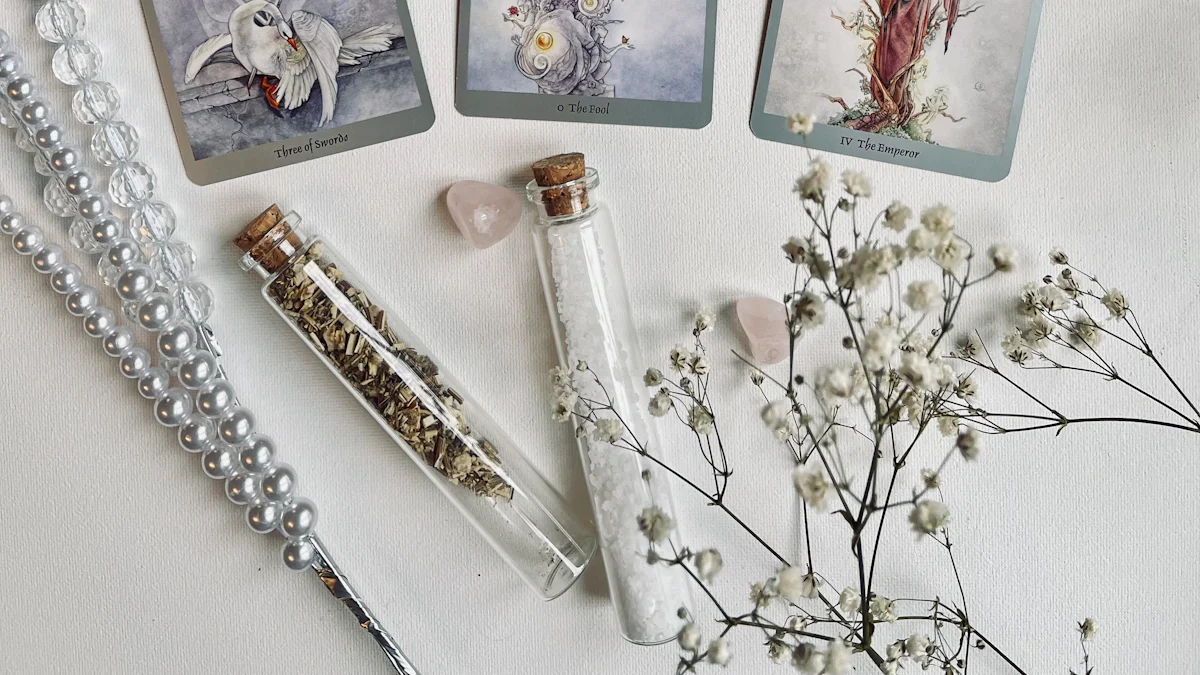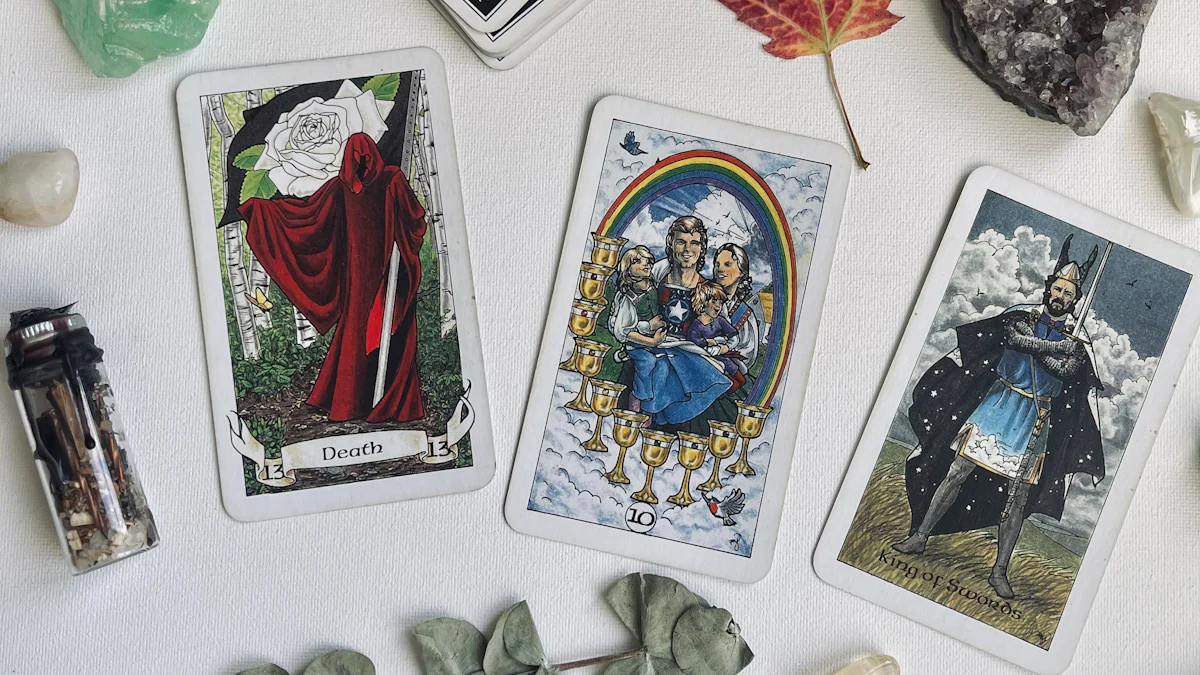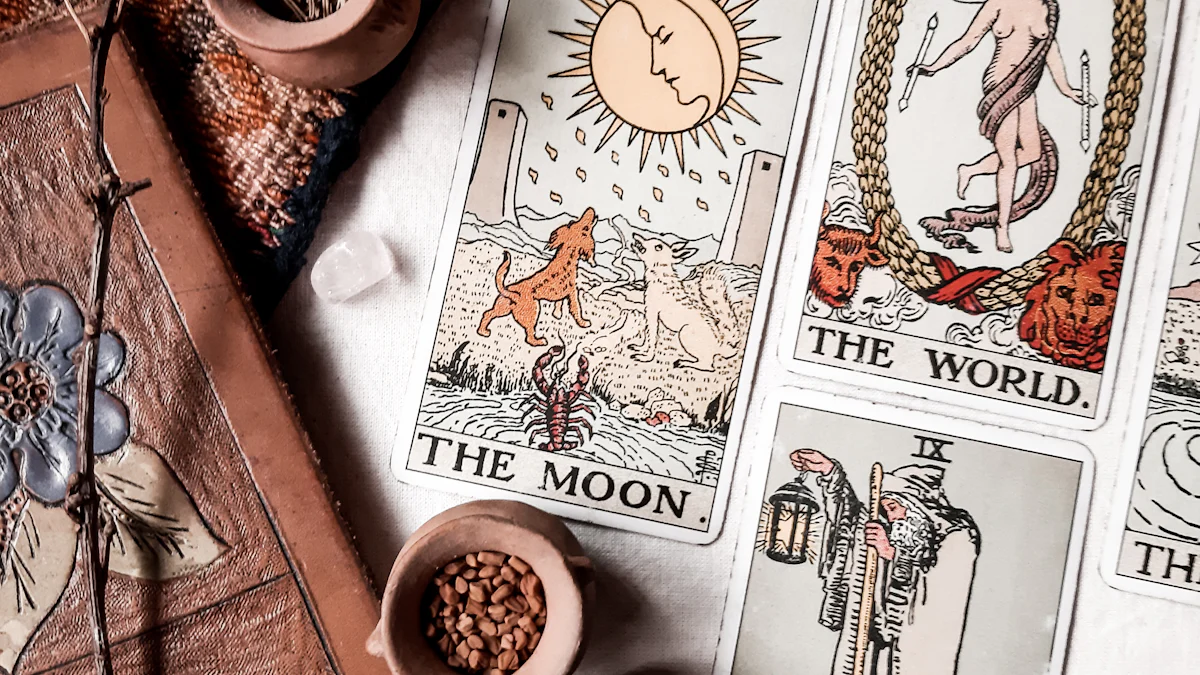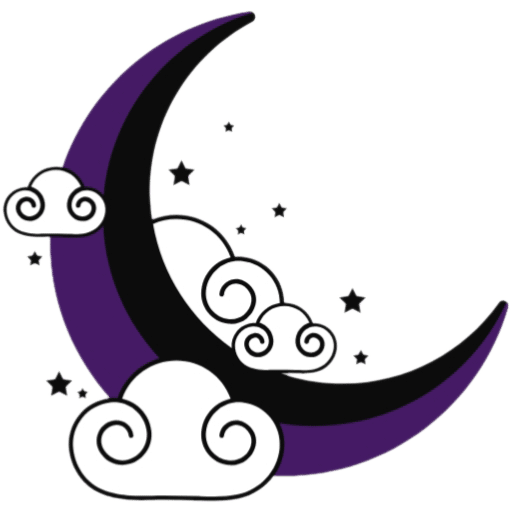
Have you ever felt stuck while writing, unsure of where your story should go next? Tarot spreads might be the creative spark you need. These cards, rich with symbols and archetypes, can help you uncover fresh ideas and explore new storytelling paths. Writers like Dion Fortune and Margaret Atwood have used tarot to shape characters and plots, proving its potential as a storytelling tool. You can try simple techniques like drawing a card daily to explore a character’s traits or mapping out scenes with spreads. The cards’ imagery taps into universal human experiences, making your stories more relatable and compelling. Why not give a tarot spread for story idea generation a try? You might just find the inspiration you’ve been searching for.
Key Takeaways
Tarot spreads can serve as powerful writing prompts, helping you explore character arcs and plot structures, making your storytelling more dynamic.
Utilize the Major and Minor Arcana cards to inspire character development and plot progression, tapping into universal themes and everyday symbolism.
Incorporate daily tarot draws into your writing routine to consistently spark creativity and overcome writer’s block, enhancing your connection to your storytelling process.
Experiment with different tarot spreads, from simple three-card layouts to more complex designs, to uncover new narrative layers and deepen your story’s emotional impact.
Understanding Tarot and Its Creative Potential

The Structure of a Tarot Deck
Major Arcana and Archetypes
The Major Arcana cards are the heart of any tarot deck. These 22 cards represent universal themes and archetypes, like The Fool, The Empress, and The World. Each card tells a story about life’s big moments—beginnings, challenges, transformations, and resolutions. For example, The Tower symbolizes sudden change or upheaval, while The Star offers hope and renewal. These archetypes can inspire you to create characters with depth and relatable struggles. Imagine a protagonist embodying The Fool’s adventurous spirit or a villain driven by The Devil’s temptations. The Major Arcana gives you a treasure trove of ideas for crafting compelling narratives.
Minor Arcana and Everyday Symbolism
The Minor Arcana focuses on the day-to-day aspects of life. It’s divided into four suits: Cups, Wands, Swords, and Pentacles. Each suit aligns with an element and a specific area of life. For instance, Cups represent emotions and relationships, while Pentacles deal with material concerns like money and health. The cards also follow a numerological structure, where numbers one through ten reflect different stages of a journey. Aces signify beginnings, while tens mark completion. This structure helps you explore your characters’ personal growth or the progression of your plot. Think of the Minor Arcana as a toolkit for adding realism and detail to your story.
How Tarot Symbols Spark Creativity
Using Imagery to Inspire Story Elements
Tarot cards are packed with vivid imagery that can ignite your imagination. The Rider-Waite-Smith deck, created in the early 1900s, is a great example. Its illustrated scenes bring the cards’ meanings to life, making it easier to connect with their symbolism. You might see The Moon card and picture a mysterious setting full of secrets, or The Sun card and imagine a joyful resolution. These images can inspire everything from your story’s mood to its setting. By focusing on the visual details, you’ll find endless ways to enrich your narrative.
Interpreting Symbols for Narrative Depth
Interpreting tarot symbols can add layers to your storytelling. Here’s how:
Tarot encourages you to switch perspectives, helping you see your story from new angles.
The cards can inspire unexpected plot twists, keeping your readers hooked.
Their rich imagery enhances visual storytelling, making your scenes more vivid and emotional.
Many creators have used tarot to deepen their narratives. Movies like The Fountain and The Ninth Gate weave tarot symbolism into their plots, exploring themes of life, death, and mystery. You can do the same by letting the cards guide your story’s twists and turns.
Practical Steps for Using Tarot Spreads in Writing
Choosing a Tarot Spread for Story Idea
Beginner-friendly spreads
If you’re new to using tarot cards for writing, start with simple spreads that spark creativity without overwhelming you. The Three Card Spread is a great choice. It’s versatile and can help you explore character arcs or plot structures. For example, you can assign the cards to represent past, present, and future, or even the three acts of a short story. Another beginner-friendly option is the Celtic Cross Spread. This spread dives deeper into character motivations and narrative dynamics, giving you a broader view of your story’s potential. These spreads act as writing prompts, guiding you to fresh ideas.
Advanced spreads for complex narratives
When you’re ready to tackle more intricate stories, advanced tarot spreads can help you map out complex narratives. Here’s a table showcasing an example of a detailed spread:
Position | Description |
|---|---|
Present Position | Current state of the story. |
Immediate Challenge | The main conflict or obstacle. |
Distant Past | Events that set the stage for current events. |
Recent Past | Recent developments affecting the story. |
Future | Near-term outcomes or consequences. |
Underlying Influence | Hidden factors driving the narrative. |
Self-Perception | How the protagonist views their situation. |
External Influences | Outside forces impacting the story. |
Hopes and Fears | Aspirations and anxieties of the characters. |
Outcome | The predicted resolution of the story arc. |
This type of tarot spread for story idea generation is perfect for crafting layered plots and exploring subplots.
Interpreting Tarot Cards for Writing
Using intuition to guide interpretations
When using tarot cards, trust your instincts. The imagery and symbolism on each card can evoke unique ideas. For example, The Moon might inspire a mysterious setting, while The Fool could suggest a character embarking on a risky journey. Let your intuition guide how you connect these symbols to your story.
Applying card meanings to characters, plots, and themes
Tarot cards are rich with meanings that can shape your story. Use them to define characters or themes. For instance:
The Lovers could represent a character’s internal conflict or a pivotal choice.
The Tower might symbolize a sudden upheaval in your plot.
The Wheel of Fortune could highlight cycles of fate in your short story.
These interpretations act as writing prompts, helping you weave deeper layers into your narrative.
Building Story Elements with Tarot
Developing characters through card archetypes
Tarot archetypes are a goldmine for character creation. Draw a card to define a character’s core traits. For example, The Magician could inspire a cunning protagonist with untapped potential. You can also explore their backstory and relationships by drawing additional cards. This method ensures your characters feel dynamic and relatable.
Crafting plots and themes with spreads
A tarot spread can outline key plot points or themes. Use a spread to map out your story’s beginning, middle, and end. For example, The Hanged Man might suggest a moment of sacrifice, while Death could signify transformation. These cards help you maintain consistent pacing and emotional balance in your story.
Examples of Tarot Spreads for Story Creation

The Three-Card Spread
Past, Present, Future for character development
The three-card spread is one of the simplest and most versatile tools for storytelling. You can use it to explore a character’s backstory, current state, and future trajectory. For example:
Past: Reflect on the character’s history or an inciting incident that shaped them.
Present: Examine their current challenges or emotional state.
Future: Predict how their journey might resolve or evolve.
This spread helps you dive into your character’s psyche and uncover motivations that drive their actions. It’s perfect for creating well-rounded, relatable characters.
Conflict, Resolution, Outcome for plot ideas
You can also adapt the three-card spread to brainstorm plot ideas. Assign each card to represent:
Conflict: The central problem or obstacle in the story.
Resolution: How the conflict might be addressed or overcome.
Outcome: The result of the resolution and its impact on the characters.
This approach works as a quick story prompt, helping you outline the core structure of your narrative. It’s a great way to kickstart your creative process when you’re stuck.
The Story Tarot Spread
Exploring story arcs with tailored spreads
The Story Tarot Spread is a more detailed option for exploring story arcs. It focuses on key elements like the main character’s inner journey, complications, and outcomes. For instance, you might draw cards to represent:
The main story question.
The central plotline.
Optional subplots.
This spread allows you to map out your story’s structure while keeping the narrative cohesive. It’s especially useful for longer works like novels or screenplays.
Using prompts to guide narrative creation
You can enhance the Story Tarot Spread by incorporating prompts. For example:
What factors are making the situation worse?
These prompts guide your interpretation of the cards, helping you craft a compelling and emotionally resonant story. A simple three-card spread can also outline a story arc, making it an effective tool for tarot storytelling.
Custom Spreads for Writers
Designing spreads for specific story needs
Sometimes, you need a spread tailored to your unique story. You can design custom tarot spreads for writers by focusing on specific elements like character relationships or thematic exploration. For example:
Use a spread to brainstorm new book ideas.
Draw cards to overcome writer’s block.
Create mini-spreads to develop subplots or secondary characters.
Custom spreads give you the flexibility to address your story’s specific challenges and opportunities.
Combining spreads for layered storytelling
For more complex narratives, try combining multiple spreads. Start with a three-card spread to outline the main plot, then add a Celtic Cross Spread to explore subplots or character arcs. This layered approach enriches your story, creating depth and nuance. It’s a powerful way to use tarot spreads for writers who want to craft intricate, multi-dimensional tales.
Advanced Techniques for Using Tarot for Creativity
Combining Multiple Spreads
Layering spreads for intricate stories
Combining tarot spreads can take your storytelling to the next level. By layering spreads, you can create intricate narratives with multiple dimensions. Start with a simple spread, like a three-card layout, to define your main story question. Then, add more spreads to explore subplots or deepen character arcs. For example, you might use one spread to outline the protagonist’s journey and another to reveal the antagonist’s motives.
You can also analyze how cards interact with each other. Look at them in groups to uncover hidden connections or themes. This approach helps you craft unexpected plot twists or foreshadow key events. Another technique is to overlay cards on an existing spread to elaborate on specific elements. For instance, if a card represents a conflict, draw additional cards to explore its root cause or resolution. These methods allow you to weave complex, layered stories that captivate your readers.
Exploring subplots with additional spreads
Tarot spreads are perfect for diving into subplots. Use a dedicated spread to focus on a secondary storyline or a supporting character’s journey. For example, a three-card spread could represent a subplot’s barrier, opportunity, and result.
Card Position | Description |
|---|---|
The Barrier | An obstacle the character faces in the subplot. |
The Opportunity | A chance to overcome the barrier. |
The Result | The outcome of their actions or a new complication that arises. |
This method not only enriches your narrative but also helps you identify where your story might need more balance or depth. If you’re stuck, ask the cards what’s blocking your progress. Their symbolism might reveal a fresh perspective or even personal insights that could inspire your creative practice.
Deepening Creativity with Intuition
Free association for unique ideas
Let your imagination run wild by practicing free association with tarot cards. Instead of sticking to traditional meanings, focus on the imagery and let your mind wander. What story does the card tell you? For example, The Ace of Wands might spark an idea about a character discovering their passion. If a card doesn’t resonate, draw another and see how they connect. This technique encourages you to think outside the box and discover unique story elements.
Letting go of rigid interpretations
Rigid interpretations can limit your creative practice. Instead, trust your intuition when working with tarot cards. The same card can mean different things depending on your story’s context. For instance, The Lovers might symbolize a romantic relationship or a tough decision. Let the cards guide you without overthinking their meanings. This flexibility opens up endless possibilities for your narrative.
Incorporating Tarot into Your Writing Routine
Daily draws for consistent inspiration
Incorporating tarot into your daily routine can keep your creativity flowing. Start each day by drawing a card and reflecting on its imagery. Use it as a prompt to brainstorm story ideas or develop a character’s backstory. A tarot journal can help you track these insights and revisit them later. This habit not only sparks new ideas but also strengthens your connection to your creative practice.
Overcoming writer’s block with tarot
Feeling stuck? Tarot cards can help you overcome writer’s block. Meditate on a card like The Ace of Wands to invite fresh inspiration. Or, use a spread to gain clarity on what’s holding you back. For example, ask the cards what your story needs or where your plot has gone off track. Their archetypes and symbols can offer new directions and help you break through creative barriers.
Tarot spreads are a fantastic way to spark creativity and generate fresh story ideas. They help you dive into character development, craft intricate plots, and explore meaningful themes. For instance, daily draws can inspire character traits, while spreads like the Inspiration Unfucker can tackle creative blocks and uncover hidden strengths.
Experimenting with tarot opens up new storytelling possibilities. You can map out scenes, conduct character interviews, or even use spreads to explore subplots. Writers like Jeanette Winterson and Margaret Atwood have used tarot to break through creative barriers and visualize deeper themes.
Trust your intuition as you work with tarot. Let the cards guide your imagination and storytelling instincts. Remember, your initial ideas—no matter how unexpected—can evolve into something extraordinary. So grab a deck, shuffle the cards, and see where your creativity takes you!


